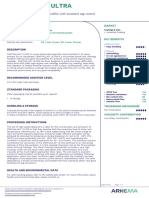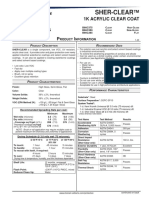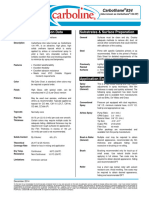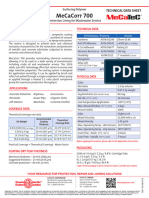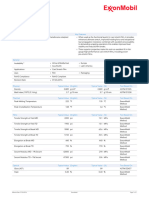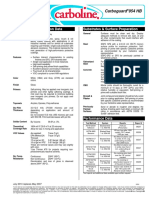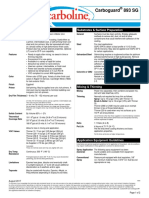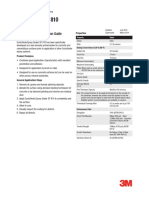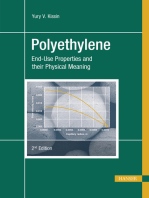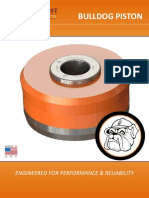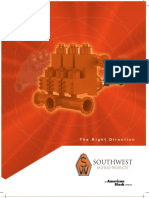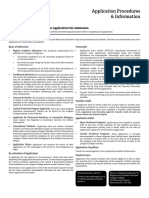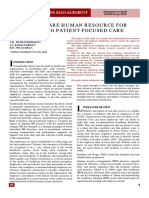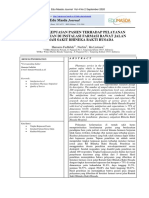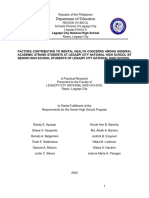Carboxane 2000: Selection & Specification Data Substrates & Surface Preparation
Carboxane 2000: Selection & Specification Data Substrates & Surface Preparation
Uploaded by
Purwanto ritzaCopyright:
Available Formats
Carboxane 2000: Selection & Specification Data Substrates & Surface Preparation
Carboxane 2000: Selection & Specification Data Substrates & Surface Preparation
Uploaded by
Purwanto ritzaOriginal Title
Copyright
Available Formats
Share this document
Did you find this document useful?
Is this content inappropriate?
Copyright:
Available Formats
Carboxane 2000: Selection & Specification Data Substrates & Surface Preparation
Carboxane 2000: Selection & Specification Data Substrates & Surface Preparation
Uploaded by
Purwanto ritzaCopyright:
Available Formats
®
Carboxane 2000
Selection & Specification Data Substrates & Surface Preparation
Generic Type Modified Siloxane Hybrid General Surfaces must be clean and dry. Employ adequate
Description Carboxane 2000 is a premium, ultra-durable coating methods to remove dirt, dust, oil and all other
that provides outstanding gloss and color retention for contaminants that could interfere with adhesion of the
exterior exposures. When used over a suitable primer coating. Refer to specific primer’s Product Data Sheet
(as a two coat system) Carboxane 2000 provides for detailed requirements of the specified primer
the barrier properties normally seen using a three- Steel SSPC-SP6 with a 1.5-2.5 mil (37.5-62.5 micron)
coat system (primer, epoxy intermediate with an surface profile for maximum protection. SSPC-
acrylic-polyurethane finish) for most environments. SP2 or SP3 as minimum requirement. Prime with
This tightly cross-linked film utilizes a UV-resistant recommended primer.
siloxane binder resulting in a finish with outstanding Galvanized Steel SSPC-SP1 and prime with specific Carboline
barrier properties and weathering performance that far primers as recommended by your Carboline sales
exceeds polyurethanes. representative.
Features • Exceptional weatherability
• Long life performance
• Outstanding gloss/color retention
Performance Data
• VOC compliant Test Method System Results
• Excellent abrasion resistance Adhesion: 859/2000 1362 psi
• Isocyanate free ASTM D4541
• Flexible Film EMMAQUA Weathering 2000 Exposure 12 mos.
Color Refer to Carboline Color Guide Gloss Retention 90%
Finish Gloss Exposure 24 mos.
Gloss Retention 73%
Primer Compatible with inorganic and organic zinc rich Exposure 32 mos.
primers, epoxies and others as recommended by Gloss Retention 61%
Carboline Technical Service Flexibility: 2000 >3/8 inch
Dry Film 3.0 - 7.0 mils (76 - 178 microns) per coat Conical Mandrel
Thickness Pencil Hardness 2000 F
As the finish of a two coat system (over a primer) a minimum of 5 mils QUV-A Weathering 2000 Exposure 4000 hours
(125 microns) is recommended. As the finish of a three coat system Gloss Retention 99%
(primer and intermediate coat), a minimum of 3 mils (75 microns) is
recommended. See Severe Exposures below. Exposure 8000 hours
80% gloss retention
Solids Content By Volume 75% +/- 2% Exposure 12000 hours
Surface Burning Flame Spread Index: 0 Gloss Retention 53%
Characteristics Smoke Developed Index: 10 South Florida 2000 Exposure 4 years
Weathering Gloss Retention 90%
Theoretical 2 2
1203 ft at 1.0 mils (29.5 m /l at 25 microns) dE: 0.45 color change
Coverage Rate 2 2
401 ft at 3.0 mils (9.8 m /l at 75 microns) Wet Adhesion: "X- 859/2000 No failure after 7 days
2 2
172 ft at 7.0 mils (4.2 m /l at 175 microns) Cut", Knife Adhesion
Allow for loss in mixing and application. Mixing & Thinning
Severe Exposures For severe marine environments (offshore structures)
Mixing Power mix Part A separately. Part B requires no
a three coat system is recommended. For other
mixing. Then combine power mix. DO NOT MIX
severe exposures, a two coat system may be used
PARTIAL KITS.
provided the minimum film thickness of 5 mils (125
microns) is achieved. Thinning Not normally required. May be thinned up to 10% (13
oz/gal) with Thinner #10 for spray, and Thinner 214,
VOC Values Thinner 10 13 oz/gal: 2.29 lbs/gal (275 g/l)
215, or 238 for brush and roll.
As Supplied 1.8 lbs/gal (216 g/l) mixed
These are nominal values and may vary with color
Ratio Part A: 2.2:1
Part B: by volume.
Dry Temp. Continuous: 200 °F (93 °C) Pot Life 8 hours at 75°F (23°C) and less at higher
Resistance Non-Continuous: 250 °F (121 °C) temperatures. Material is moisture sensitive. If left
uncovered for extended periods or under very high
humidity conditions, check for and remove any
skinning that may occur.
September 2015 2000
To the best of our knowledge the technical data contained herein is true and accurate on the date of publication and is subject to change without prior notice. User must contact Carboline Company
to verify correctness before specifying or ordering. No guarantee of accuracy is given or implied. We guarantee our products to conform to Carboline quality control. We assume no responsibility for
coverage, performance or injuries resulting from use. Liability, if any, is limited to replacement of products. NO OTHER WARRANTY OR GUARANTEE OF ANY KIND IS MADE BY CARBOLINE,
EXPRESS OR IMPLIED, STATUTORY, BY OPERATION OF LAW, OR OTHERWISE, INCLUDING MERCHANTABILITY AND FITNESS FOR A PARTICULAR PURPOSE. Carboline® and Carboguard®
are registered trademarks of Carboline Company.
Page 1 of 2
®
Carboxane 2000
Application Equipment Guidelines Packaging, Handling & Storage
Listed below are general equipment guidelines for the application of this product. Job site conditions Shelf Life Part A: 24 months at 76°F (24°C)
may require modifications to these guidelines to achieve the desired results.
Part B: 24 months at 76°F (24°C)
Spray Application This is a high solids coating and may require *Shelf Life: (actual stated shelf life) when kept at recommended storage
conditions and in original unopened containers.
(General) adjustments in spray techniques. Wet film thickness
is easily and quickly achieved. The following spray Shipping Weight 1 Gallon Kit - 13 lbs (6 kg)
equipment has been found suitable and is available (Approximate) 5 Gallon Kit - 67 lbs (30 kg)
from manufacturers.
Storage 40 -110°F (4°C-43°C)
Airless Spray Pump Ratio: 30:1 (min.) Temperature & 0-90% Relative Humidity
Volume Output: 2.5 gpm min. (11.5 l/min min.) Humidity
Material Hose: ½” I.D. min. (12.5mm min.)
Tip Size: 0.017-0.021” (0.43-0.53mm) Flash Point Part A: 96°F (36°C)
Output Pressure: 1500-2000 psi (105-140kg/cm²) (Setaflash) Part B: 75°F (24°C)
Thinner 10: 83°F (28°C)
Brush & Roller Multiple coats may be required to obtain desired Thinner 214: 102°F (38°C)
(General) appearance, recommended dry film thickness and Thinner 215: 128°F (53°C)
adequate hiding. Avoid excessive re-brushing or re- Thinner 238: 102°F (38°C)
rolling. Thinner 2: 23°F (-5°C)
Brush Use a medium natural bristle brush. Storage Store Indoors. KEEP DRY.
Roller Use a short to medium-nap mohair roller cover with This product is solvent based and not affected by excursions below
solvent resistant core. these published storage temperatures, down to 10°F, for a duration of no
more than 14 days. Always inspect the product prior to use to make sure
it is smooth and homogeneous when properly mixed.
Application Conditions
Condition Material Surface Ambient Humidity
Minimum 50 °F (10 °C) 35 °F (2 °C) 35 °F (2 °C) 20%
Maximum 90 °F (32 °C) 110 °F (43 °C) 110 °F (43 °C) 90%
Industry standards are for substrate temperatures to be 5°F (3°C) above the dew point. Protect
from high humidity, dew and direct moisture contact until fully cured. Application and/or curing in
humidities above maximum, or exposure to moisture from rain or dew may result in a loss of gloss
and/or staining of the product.
Curing Schedule
Surface Temp. Dry to Recoat Dry to Touch Hard Cure
& 50% Relative
Humidity
35 °F (2 °C) 24 Hours 8 Hours 30 Hours
60 °F (16 °C) 12 Hours 3 Hours 24 Hours
75 °F (24 °C) 6 Hours 2 Hours 18 Hours
These times are based on recommended coverage rates. Curing under low humidity conditions will
extend times. Maximum recoat for this product is 30 days. After this period, it is best to degloss the
surface by abrasive blasting or sanding prior to recoating.
Note: Like many coatings, this coating will develop full adhesion over the initial weeks
following application.
*Hard Cure = Fingernail hard
Cleanup & Safety
Cleanup Use Thinner #2 or Acetone. In case of spillage, absorb
and dispose of in accordance with local applicable
regulations.
Safety Read and follow all caution statements on this product
data sheet and on the MSDS for this product. Employ
normal workmanlike safety precautions.
Ventilation When used in enclosed areas, thorough air circulation
must be used during and after application until the
coating is cured. The ventilation system should be
capable of preventing the solvent vapor concentration
from reaching the lower explosion limit for the solvents
used. User should test and monitor exposure levels
to insure all personnel are below guidelines. If not
sure or if not able to monitor levels, use MSHA/NIOSH
approved supplied air respirator.
September 2015 2000
To the best of our knowledge the technical data contained herein is true and accurate on the date of publication and is subject to change without prior notice. User must contact Carboline Company
to verify correctness before specifying or ordering. No guarantee of accuracy is given or implied. We guarantee our products to conform to Carboline quality control. We assume no responsibility for
coverage, performance or injuries resulting from use. Liability, if any, is limited to replacement of products. NO OTHER WARRANTY OR GUARANTEE OF ANY KIND IS MADE BY CARBOLINE,
EXPRESS OR IMPLIED, STATUTORY, BY OPERATION OF LAW, OR OTHERWISE, INCLUDING MERCHANTABILITY AND FITNESS FOR A PARTICULAR PURPOSE. Carboline® and Carboguard®
are registered trademarks of Carboline Company.
Page 2 of 2
You might also like
- Carboxane 2000 PDSDocument4 pagesCarboxane 2000 PDSBERSE MAJU INDONESIANo ratings yet
- CarbolineDocument18 pagesCarbolineimaduddinshaNo ratings yet
- Resuline 2013 07Document2 pagesResuline 2013 07Alex BocicaNo ratings yet
- F13 - Carboguard 893-Zn PDS 10-09Document2 pagesF13 - Carboguard 893-Zn PDS 10-09naveenbaskaran1989No ratings yet
- Carboguard 890 PDSDocument2 pagesCarboguard 890 PDSKhemaraj PathNo ratings yet
- Carbothane 130 Clear CoatDocument2 pagesCarbothane 130 Clear CoatEugene PadillaNo ratings yet
- Carboguard 890 GF PDSDocument2 pagesCarboguard 890 GF PDSfazeel mohammedNo ratings yet
- 4C20_TDSDocument2 pages4C20_TDSsumitNo ratings yet
- Carboline Carboguard 890 PDSDocument2 pagesCarboline Carboguard 890 PDSSamNo ratings yet
- Carbothane 133 HB PDSDocument3 pagesCarbothane 133 HB PDStiennv.blcmNo ratings yet
- Carboguard 60: Selection & Specification Data Substrates & Surface PreparationDocument2 pagesCarboguard 60: Selection & Specification Data Substrates & Surface PreparationImran AhmadNo ratings yet
- Two Pack Non-Yellowing PU Floor FinishDocument3 pagesTwo Pack Non-Yellowing PU Floor FinishReubz FishingNo ratings yet
- Carboguard 890 GF PDSDocument2 pagesCarboguard 890 GF PDStiennv.blcmNo ratings yet
- Carbomastic 801 PDFDocument2 pagesCarbomastic 801 PDFkayNo ratings yet
- Carbozinc 11 WB: Selection & Specification Data Substrates & Surface PreparationDocument2 pagesCarbozinc 11 WB: Selection & Specification Data Substrates & Surface PreparationPurwanto ritzaNo ratings yet
- Amercoat 450HDocument2 pagesAmercoat 450HJairo ArroyoNo ratings yet
- Interthane 990 PICDocument2 pagesInterthane 990 PICSahab DeenNo ratings yet
- Luxafloor ECO: Water Borne Epoxy Floor CoatingDocument2 pagesLuxafloor ECO: Water Borne Epoxy Floor CoatinglivefreakNo ratings yet
- Selection & Specification Data Substrates & Surface PreparationDocument2 pagesSelection & Specification Data Substrates & Surface PreparationJuanNo ratings yet
- Carbothane 133 FLV PDSDocument2 pagesCarbothane 133 FLV PDSHomer SilvaNo ratings yet
- Product Data Sheet: Akzonobel Powder CoatingsDocument3 pagesProduct Data Sheet: Akzonobel Powder CoatingsFerhat ÖzcanNo ratings yet
- M06 Alkyd Metal Primer: Features General PropertiesDocument2 pagesM06 Alkyd Metal Primer: Features General Propertiesplj0001No ratings yet
- Carbozinc 859Document2 pagesCarbozinc 859Khemaraj PathNo ratings yet
- Allnex - WB Macrynal - Bilingual - FinalDocument23 pagesAllnex - WB Macrynal - Bilingual - Finalichsan hakimNo ratings yet
- Carboguard 690: Selection & Specification Data Selection & Specification DataDocument2 pagesCarboguard 690: Selection & Specification Data Selection & Specification DataImran AhmadNo ratings yet
- SubseaLV DatasheetDocument1 pageSubseaLV DatasheetPablo TorresNo ratings yet
- Sealbond EPC-100 - TDS & MSDSDocument7 pagesSealbond EPC-100 - TDS & MSDSmaridelljabonilloNo ratings yet
- TDS - CRAYVALLAC® ULTRA - en - WWDocument1 pageTDS - CRAYVALLAC® ULTRA - en - WWrndsb.aopNo ratings yet
- General Properties Viscosity Aging: PVC Paste Resin (Homopolymer)Document2 pagesGeneral Properties Viscosity Aging: PVC Paste Resin (Homopolymer)AminulIslamNo ratings yet
- Weberfloor Spectro UV 803 Hammer ToneDocument2 pagesWeberfloor Spectro UV 803 Hammer Tonefuadi aszaNo ratings yet
- Commercial NinetyFive 340 Product ProfileDocument1 pageCommercial NinetyFive 340 Product ProfileOmer MustafaNo ratings yet
- CemFIL AntiCrak HP 6736 Product Sheet WW 10-2014 Rev8 en FinalDocument2 pagesCemFIL AntiCrak HP 6736 Product Sheet WW 10-2014 Rev8 en FinalvliegenkristofNo ratings yet
- En GBDocument3 pagesEn GBAndrea Pamela León AlgarañazNo ratings yet
- Protective & Marine Coatings: Sher-Clear™Document4 pagesProtective & Marine Coatings: Sher-Clear™Ana CabreraNo ratings yet
- PRIMAL™ AC-337ER Highly Versatile Pure Acrylic EmulsionDocument11 pagesPRIMAL™ AC-337ER Highly Versatile Pure Acrylic EmulsionXuxo XuxitoNo ratings yet
- Carbothane 834 PDSDocument2 pagesCarbothane 834 PDSMuhammad RizwanNo ratings yet
- MeCaTeC MeCaCorr 700Document1 pageMeCaTeC MeCaCorr 700Camilo Andrés Vargas JiménezNo ratings yet
- Macropoxy C400V3Document2 pagesMacropoxy C400V3nellyNo ratings yet
- Advapoxy 1500: DescriptionDocument4 pagesAdvapoxy 1500: Descriptionashraf.mohammad.alkhatibNo ratings yet
- Kingspan Spectrum™: Premium Organic Coating SystemDocument4 pagesKingspan Spectrum™: Premium Organic Coating SystemMiso KowacNo ratings yet
- Kingspan Spectrum™: Premium Organic Coating SystemDocument4 pagesKingspan Spectrum™: Premium Organic Coating SystemNikolaNo ratings yet
- Carbomastic 18 NTDocument2 pagesCarbomastic 18 NTtiennv.blcmNo ratings yet
- Carbozinc Data SheetDocument2 pagesCarbozinc Data SheetIra Purnama SariNo ratings yet
- Carbothane 8815Document2 pagesCarbothane 8815Roberto LeonNo ratings yet
- Carbomastic_94_PDSDocument4 pagesCarbomastic_94_PDSirwanNo ratings yet
- Carboguard_635_PDSDocument5 pagesCarboguard_635_PDStry9ddj86gNo ratings yet
- Vistamaxx 6000Document2 pagesVistamaxx 6000Jimmys GothiqueNo ratings yet
- Carboguard 954 HB PDS 7-10Document2 pagesCarboguard 954 HB PDS 7-10raja020No ratings yet
- Carboguard 893 SG PDFDocument2 pagesCarboguard 893 SG PDFQA QCNo ratings yet
- Carbomastic15BNX EngDocument2 pagesCarbomastic15BNX Engfazeel mohammedNo ratings yet
- 467 MPDocument3 pages467 MPjgNo ratings yet
- Epoxy Sealer SP810Document2 pagesEpoxy Sealer SP810melvinkorahNo ratings yet
- Sikagard 62 - InglesDocument9 pagesSikagard 62 - InglesMisael GómezNo ratings yet
- Acematt Ok 412Document1 pageAcematt Ok 412optimus_1404No ratings yet
- Product Data: Carboguard 190 HDocument2 pagesProduct Data: Carboguard 190 HClarkFedele27100% (1)
- Carboguard 893 SG PDSDocument2 pagesCarboguard 893 SG PDSAhmed ElbahrawyNo ratings yet
- Carbozinc 859: Selection & Specification DataDocument5 pagesCarbozinc 859: Selection & Specification DataFrancis BautistaNo ratings yet
- Neorez 600Document1 pageNeorez 600Abhineet ShrivastavaNo ratings yet
- PRIMAL™ AC-2337: Pure Acrylic Emulsion PolymerDocument6 pagesPRIMAL™ AC-2337: Pure Acrylic Emulsion PolymerSameer AhmedNo ratings yet
- Well Service Pump Brochure v8Document2 pagesWell Service Pump Brochure v8Purwanto ritzaNo ratings yet
- Bulldog PistonDocument2 pagesBulldog PistonPurwanto ritzaNo ratings yet
- Centrifugal PumpDocument2 pagesCentrifugal PumpPurwanto ritzaNo ratings yet
- SWOP BrochureDocument16 pagesSWOP BrochurePurwanto ritzaNo ratings yet
- Maintenance Instruction 2Document18 pagesMaintenance Instruction 2Purwanto ritzaNo ratings yet
- Hydraulic Seat Puller KitDocument2 pagesHydraulic Seat Puller KitPurwanto ritzaNo ratings yet
- SWND General Data SheetDocument1 pageSWND General Data SheetPurwanto ritzaNo ratings yet
- Basic Generator, WIP3 Ver01-Page3Document1 pageBasic Generator, WIP3 Ver01-Page3Purwanto ritzaNo ratings yet
- Simatic Automation System S7-300 CPU 317TF-2 DP: Controlling A SINAMICS S120 With Safety FunctionsDocument74 pagesSimatic Automation System S7-300 CPU 317TF-2 DP: Controlling A SINAMICS S120 With Safety FunctionsPurwanto ritzaNo ratings yet
- Basic Generator, WIP3 Ver01-Page4Document1 pageBasic Generator, WIP3 Ver01-Page4Purwanto ritzaNo ratings yet
- Carbozinc 11 WB: Selection & Specification Data Substrates & Surface PreparationDocument2 pagesCarbozinc 11 WB: Selection & Specification Data Substrates & Surface PreparationPurwanto ritzaNo ratings yet
- 0229B1NL 2 UsansiDocument8 pages0229B1NL 2 UsansiPurwanto ritzaNo ratings yet
- 759-311, 759-312 WAGO Interface Software: Scada OPC Client Soft SPS Soft SPSDocument1 page759-311, 759-312 WAGO Interface Software: Scada OPC Client Soft SPS Soft SPSPurwanto ritzaNo ratings yet
- 0228a1nl 2 UsansiDocument10 pages0228a1nl 2 UsansiPurwanto ritzaNo ratings yet
- Erin Ann Bliss-2e15376ac0e059eDocument10 pagesErin Ann Bliss-2e15376ac0e059eDiana JohnsonNo ratings yet
- Top 100 Synonyms and Antonyms MergedDocument18 pagesTop 100 Synonyms and Antonyms MergedabhisheksubarpurNo ratings yet
- Event Sample Observations in Childcare - Aussie Childcare NetworkDocument1 pageEvent Sample Observations in Childcare - Aussie Childcare NetworkSafiya ShahzadNo ratings yet
- Stia Porfoma FinalDocument18 pagesStia Porfoma FinalRajeshKumarJainNo ratings yet
- Feline Anemia Diagnostic AlgorithmDocument1 pageFeline Anemia Diagnostic AlgorithmEd BlackadderNo ratings yet
- RSG Beginner and Intermediate HMDocument57 pagesRSG Beginner and Intermediate HMprakashroshan79100% (1)
- SAFC Pharma - Arklow Facility - Commercial Scale API ManufacturingDocument2 pagesSAFC Pharma - Arklow Facility - Commercial Scale API ManufacturingSAFC-GlobalNo ratings yet
- Placement Brochure of SPH SRM UniversityDocument59 pagesPlacement Brochure of SPH SRM UniversityShobhitNo ratings yet
- 0201 01Document3 pages0201 01Alex ChenNo ratings yet
- Call ReportDocument1 pageCall ReportRagav RaguNo ratings yet
- Langara College Application FormDocument5 pagesLangara College Application FormWAVESOVERSEAS1100% (1)
- Jurnal Tentang HRDDocument6 pagesJurnal Tentang HRDJemi Fiktor SabnenoNo ratings yet
- 2005-Intravenous Immunoglobulin in The Management of Hemolytic Disease of The Newborn.Document8 pages2005-Intravenous Immunoglobulin in The Management of Hemolytic Disease of The Newborn.蔡黑面No ratings yet
- Unit 4 ONLINE 1Document12 pagesUnit 4 ONLINE 1huynhthihonganh05No ratings yet
- Jharkhand Current Affairs 2017 by AffairsCloudDocument10 pagesJharkhand Current Affairs 2017 by AffairsCloudniteen kumarNo ratings yet
- Government of West Bengal Department of Health and Family Welfare, Wing-A, 4 Floor, Swasthya Bhavan GN 29, Sector - V, Salt Lake, Kolkata - 700091Document33 pagesGovernment of West Bengal Department of Health and Family Welfare, Wing-A, 4 Floor, Swasthya Bhavan GN 29, Sector - V, Salt Lake, Kolkata - 700091meenakshi.r.agrawalNo ratings yet
- LAVAGUE - 52 11janvier SANDLE PDFDocument5 pagesLAVAGUE - 52 11janvier SANDLE PDFAllen Wei ChnugNo ratings yet
- Cost BaselineDocument3 pagesCost BaselineAmandeep SinghNo ratings yet
- Selected Supplications (Hizb Al-Nasr by Haddad and Hizb Al-Nasr by Shadhili)Document2 pagesSelected Supplications (Hizb Al-Nasr by Haddad and Hizb Al-Nasr by Shadhili)PharpurX1 BHINo ratings yet
- 103 230 1 PBDocument13 pages103 230 1 PBMkf FaridliNo ratings yet
- Elc550 Term PaperDocument6 pagesElc550 Term PaperAllisya NasirNo ratings yet
- Effect of Newer Antioxidants On The Bond Strength of Composite On Bleached EnamelDocument6 pagesEffect of Newer Antioxidants On The Bond Strength of Composite On Bleached EnamelFilipe QueirozNo ratings yet
- Relationship Between Chemotherapy Side Effects On Gastrointestinal System and Quality of Life of Pediatric Acute Lymphoblastic Leukemia PatientsDocument8 pagesRelationship Between Chemotherapy Side Effects On Gastrointestinal System and Quality of Life of Pediatric Acute Lymphoblastic Leukemia PatientsInternational Journal of Innovative Science and Research TechnologyNo ratings yet
- Candidate Hall TicketDocument2 pagesCandidate Hall TicketSwastik MaheshwaryNo ratings yet
- New ARIETTA 750 FF EU English 07 2021 v1Document7 pagesNew ARIETTA 750 FF EU English 07 2021 v1DANIA BWIDANI100% (1)
- Resin Aj 07 Data SheetDocument2 pagesResin Aj 07 Data SheetAsit RayNo ratings yet
- Lecture 5 - Facial Pain and TMJ DiseaseDocument6 pagesLecture 5 - Facial Pain and TMJ DiseaseJeff ChadwickNo ratings yet
- Research-G2-12-Gas-C-Chapter 1-3Document24 pagesResearch-G2-12-Gas-C-Chapter 1-3Nicole Ann BaroniaNo ratings yet
- Saint Paul University Dumaguete College of Nursing: Dumaguete City 2 Semester, Academic Year 2022-2023Document52 pagesSaint Paul University Dumaguete College of Nursing: Dumaguete City 2 Semester, Academic Year 2022-2023Crystal ValdezNo ratings yet
- Review of Related Literature and StudiesDocument4 pagesReview of Related Literature and Studiesjayesmine barlongay100% (1)



























